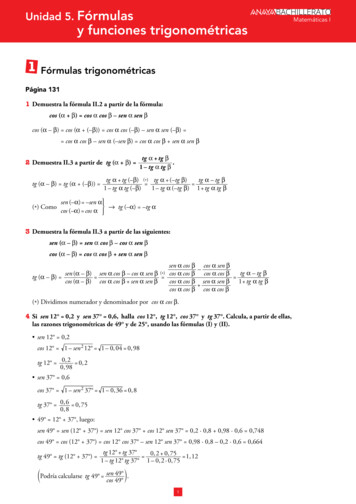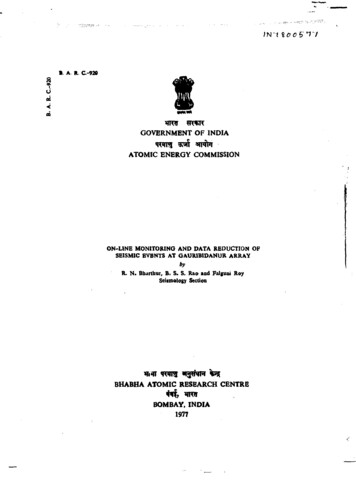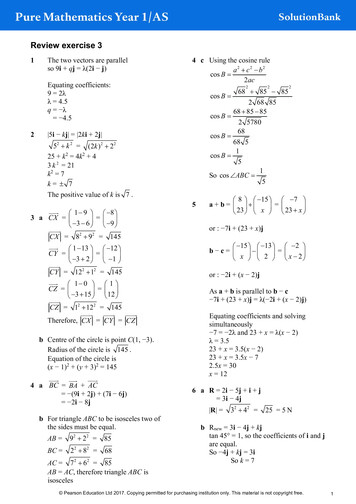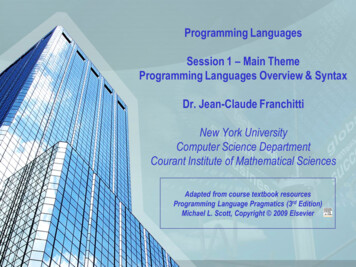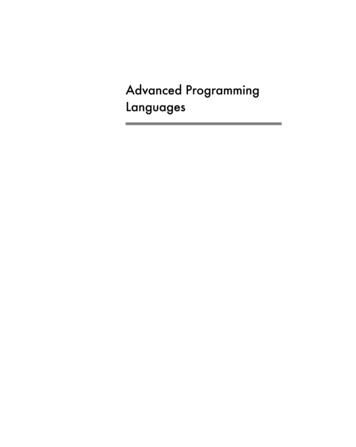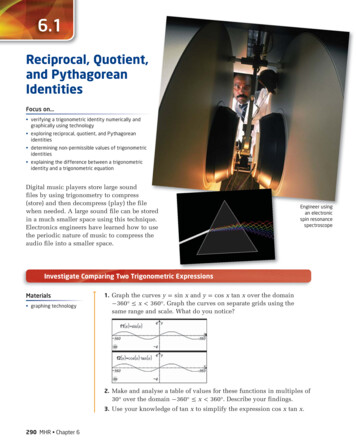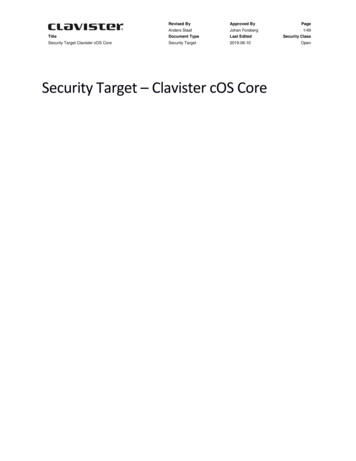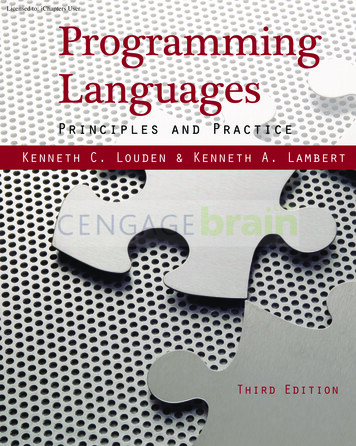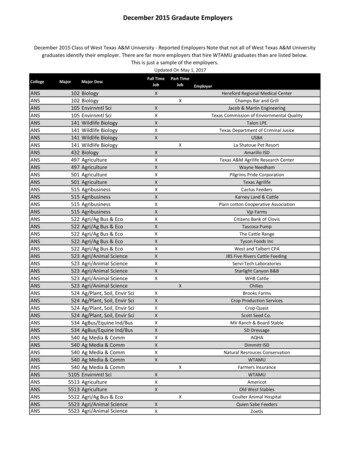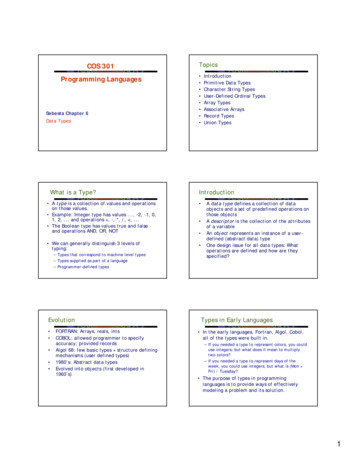
Transcription
COS 301Programming LanguagesSebesta Chapter 6Data TypesWhat is a Type? A type is a collection of values and operationson those values. Example: Integer type has values ., -2, -1, 0,1, 2, . and operations , -, *, /, , . The Boolean type has values true and falseand operations AND, OR, NOT We can generally distinguish 3 levels oftyping:– Types that correspond to machine level types– Types supplied as part of a language– Programmer-defined typesEvolution FORTRAN: Arrays, reals, ints COBOL: allowed programmer to specifyaccuracy; provided records Algol 68: few basic types structure definingmechanisms (user defined types) 1980’s: Abstract data types Evolved into objects (first developed in1960’s)Topics IntroductionPrimitive Data TypesCharacter String TypesUser-Defined Ordinal TypesArray TypesAssociative ArraysRecord TypesUnion TypesIntroduction A data type defines a collection of dataobjects and a set of predefined operations onthose objects A descriptor is the collection of the attributesof a variable An object represents an instance of a userdefined (abstract data) type One design issue for all data types: Whatoperations are defined and how are theyspecified?Types in Early Languages In the early languages, Fortran, Algol, Cobol,all of the types were built in.– If you needed a type to represent colors, you coulduse integers; but what does it mean to multiplytwo colors?– If you needed a type to represent days of theweek, you could use integers, but what is (Mon Fri) / Tuesday? The purpose of types in programminglanguages is to provide ways of effectivelymodeling a problem and its solution.1
Levels of Abstraction5.1 Type Errors Ultimately every computable problem has to be expressed as astring of 1’s and 0’s; likewise the solution is also thus represented Machine data carries no type information. Machines contain bit strings. Example: 0100 0000 0101 1000 0000 0000 0000 0000 Assembly languages were invented to provide mnemonics (such asSUB and LOAD) and human-readable numbers to replace strings of1’s and 0’s HLLs were invented to provide a virtual machine that hides thereal machine with its registers and native machine types– Increasingly sophisticated typing schemes have been invented to maphuman abstractions such as colors, days, documents, weather systemsin language that corresponds to the human abstraction rather than toany machine, virtual or otherwise– OO programming just another level of typing abstractionBit Strings 0100 0000 0101 1000 0000 0000 0000 0000 Can be––––The floating point number 3.375The 32-bit integer 1,079,508,992Two 16-bit integers 16472 and 0Four ASCII characters: @ X NUL NUL What else? What about 1111 1111?Type Errors A type error is any error that arises becausean operation is attempted on a data type forwhich it is undefined. Type errors are easy to make in assemblylanguage programming. HLLs help to reduce the number of typeerrors.– As the level of abstraction rises, type errors tendto decrease A type system provides a basis for detectingtype errors.Primitive Data Types Almost all programming languages provide aset of primitive data types– Primitive data types: Those not defined in terms ofother data types Some primitive data types are merelyreflections of the hardware Others require only a little non-hardwaresupport for their implementationPrimitive Data types in C, Ada, JavaTypeByteCcharIntegershort, int,longfloat, double,extended doublecharFloatCharBoolAdaJavabyteInteger, Natural,Positiveshort, int, longFloat, DecimalCharacterBooleanfloat, doublecharbooleanNotes:1. C char and integer types can be signed or unsigned2. Ada provides Natural and Positive as subclasses of integer3. All Java integers are signed4. Ada provides floating and fixed point types withprogrammer-specified precision2
Primitive Data Types: IntegerPrimitive Data Types: Integer Almost always an exact reflection of thehardware so the mapping is trivial There may be as many as eight differentinteger types in a language When integers are mapped onto machinetypes, they have a limited range but arithmeticis very efficient Starting with LISP, some languages support aconceptually unlimited integer– C and C support signed and unsigned byte,short, int, long Signed 2’s complement– Java’s supports signed integer sizes: byte,short, int, long C/C mapping to machine data types cancause problems– What do relational operators mean when we havesigned on one side and unsigned on the other?984375928418932092850984590384590835 Starting with LISP, some languages support aconceptually unlimited integer Modern languages include Python, Haskell,Smalltalk– A language implementation may use a machinerepresentation for small integers and then switch toa less efficient representation when neededIntegers mapped to machine typesOverflow and Wraparound Most languages do not specify the number ofbits associated with any of the basic types –this is implementation dependent In most languages, the numeric types are finitein size and correspond to a particular wordsize. So a b may overflow the finite range.– Java is an exception: byte 8, short 16, int 32,long 64– Ada allows programmer to specify size, will raiseexception at compile time if too many bits Many languages fail to generate an exceptionwhen overflow occurs.– This is an example of the conflict between run-timeefficiency and type safety. What is the cost imposedby generating exceptions on overflow?– a,b,c a (b c) (a b) c Due to the peculiarities of the most commonmachine representation for signed integers (2’scomplement), an overflow of positive numbersresults in a sum with a negative sign Also in some C-like languages, the equality andrelational operators produce an int, not aBooleanPrimitive Data Types: Floating PointIEEE Floats Model real numbers, but only as approximations Uses “binamal”: 1.0112 2.375 Because there are only two digits in binary, IEEE formatsnormalize numbers so that a 1 in front of the binamal point sothat every number other than 0 will start with a 1. The leading 1 is NOT stored in the number. This provides an extra bit of precision and is sometimes referredto as a HIDDEN BIT.– There are significant problems with floating point computation– Machine representations generally only represent sums ofpowers of two– Apparently easy and tractable numbers such as 0.1 have noprecise binary representations Languages for scientific use support at least twofloating-point types (e.g., float and double;sometimes more Usually exactly like the hardware, but not always– Some older scientific data is only accessible through softwaresimulation of old hardware because formats have changed andolder numbers are no longer precisely representableSignBitBias-127 ExponentE 8-bitsUnsigned Fraction F 23 bitsVal (-1) Sign * 1.F*2 (E-127) if E 0 Current standard is IEEE Floating-Point Standard 7543
IEEE 64-bit Format (double)Primitive Data Types: Complex Range of float is approximately 1038 with 6-7digits of precision for 32 bits 10308 with 14-15 digits of precision for 64 bits Some languages support a complex type, e.g.,C99, Fortran, and Python Each value consists of two floats, the real partand the imaginary part Literal form (in Python):(7 3j), where 7 is the real part and 3 is theimaginary partSignBitBias-1023 ExponentE 11-bitsUnsigned Fraction F 52 bitsVal (-1) Sign * 1.F*2 (E-1023) if E 0Primitive Data Types: DecimalPrimitive Data Types: Boolean Usually for business applications (money) Simplest of all types Range of values: two elements, one for “true”and one for “false” Could be implemented as bits, but usually atleast bytes– Essential to COBOL– C# offers a decimal data type– Almost any DBMS offers decimal data type forstorage Stores a fixed number of decimal digits, inbinary coded decimal (BCD) Advantage: accuracy – more precise than IEEEfloats Disadvantages: limited range, uses morememory and much more CPU time than floats Some hardware has direct supportBooleans Booleans are problematic in some languagesthat support special values to indicate missingor uninitialized data– Null– Empty– Missing What is false && null?– Advantage: readability C (until 1999) did not have a Boolean type– Booleans were represented as ints Many languages cast freely between Booleansand other types– 0 false, anything else true– “” false, non-empty string trueBooleans in PHP PHP is a bit tricky because it coerces types freelyand uses a rather strange internal representationfor Booleans– 1 TRUE ?phpecho "Theecho "The? Output:The valueThe value“” falsevalue of TRUE is- ",TRUE," -\n";value of FALSE is- ",FALSE," -\n";of TRUE is- 1 of FALSE is- -4
Primitive Data Types: CharacterASCII Characters Characters are stored as numeric codings American Standard Code for InformationInterchange (ASCII) was a long time standard Extended Binary Coded Decimal InterchangeCode (EBCDIC) was used by IBM mainframes Problem: ASCII is a 7 bit code and EBCDIC an 8bit code Languages that use ASCII implicitly normallyuse 8 bits to represent each character The meaning of the upper 128 charactersvaries with the operating system or othersoftware Often the ISO 8859 encoding is used torepresent characters used in Europeanlanguages– There are more than 128 characters that we mightwant to useUnicode Unicode is a system designed to transcendcharacter encodings - it is not simply an expansionof ASCII code To understand Unicode you must also understandUCS (Universal Character Set) or ISO 10646 UCS is like a giant alphabet (32 bits) designed toencode any human character known– And some that aren’t human – it includes a “private usearea” that has been used for Klingon characters amongother thingsRecommended Reading - Unicode An excellent and concise introduction:The Absolute Minimum Every Software DeveloperAbsolutely, Positively Must Know About Unicode andCharacter Sets (No Unicode.html Unicode provides algorithms for encoding UCScharactersFrom unicode.org See Unicode provides a unique number for every character, no matterwhat the platform, no matter what the program, no matter what thelanguage. The Unicode Standard has been adopted by such industryleaders as Apple, HP, IBM, JustSystems, Microsoft, Oracle, SAP, Sun,Sybase, Unisys and many others. Unicode is required by modernstandards such as XML, Java, ECMAScript (JavaScript), LDAP, CORBA3.0, WML, etc., and is the official way to implement ISO/IEC 10646. Itis supported in many operating systems, all modern browsers, andmany other products. The emergence of the Unicode Standard, andthe availability of tools supporting it, are among the most significantrecent global software technology trends.Unicode Unicode can be implemented with differentcharacter encodings– Most common are UTF-8, UTF-16 (UCS-2), and UTF-32(UCS-4)– UTF 8 is a variable length encoding that convenientlyencodes ASCII in single bytes Unicode has been adopted by many modernlanguages and nearly all popular operating systems– Java, XML, .NET framework, Python, Ruby etc. For a Unicode tutorial, seehttp://www.unicode.org/notes/tn23/tn23-1.html5
Character String TypesCharacter String Types Operations String values are sequences of characters Design issues: Typical operations:–––––– Is it a primitive type or just a special kind of array?– Should the length of strings be static or dynamic?Assignment and copyingComparison ( , , etc.)CatenationSubstring referencePattern matchingString LibrariesExample: PHP string functions 1 As string processing has become increasinglyimportant library support has become muchmore extensive Concatenation, substring extraction, caseconversion, searching, pattern matching,regular expressions, substring replacement, . addcslashes — Quote string with slashes in a C styleaddslashes — Quote string with slashesbin2hex — Convert binary data into hexadecimal representationchop — Alias of rtrimchr — Return a specific characterchunk split — Split a string into smaller chunksconvert cyr string — Convert from one Cyrillic character set to anotherconvert uudecode — Decode a uuencoded stringconvert uuencode — Uuencode a stringcount chars — Return information about characters used in a stringcrc32 — Calculates the crc32 polynomial of a stringcrypt — One-way string encryption (hashing)echo — Output one or more stringsexplode — Split a string by stringfprintf — Write a formatted string to a streamget html translation table — Returns the translation table used by htmlspecialchars andhtmlentitieshebrev — Convert logical Hebrew text to visual texthebrevc — Convert logical Hebrew text to visual text with newline conversionhtml entity decode — Convert all HTML entities to their applicable charactershtmlentities — Convert all applicable characters to HTML entitiesExample: PHP string functions 2Example: PHP string functions 3 html entity decode — Convert all HTML entities to their applicable charactershtmlentities — Convert all applicable characters to HTML entitieshtmlspecialchars decode — Convert special HTML entities back to charactershtmlspecialchars — Convert special characters to HTML entitiesimplode — Join array elements with a stringjoin — Alias of implodelcfirst — Make a string's first character lowercaselevenshtein — Calculate Levenshtein distance between two stringslocaleconv — Get numeric formatting informationltrim — Strip whitespace (or other characters) from the beginning of a stringmd5 file — Calculates the md5 hash of a given filemd5 — Calculate the md5 hash of a stringmetaphone — Calculate the metaphone key of a stringmoney format — Formats a number as a currency stringnl langinfo — Query language and locale informationnl2br — Inserts HTML line breaks before all newlines in a stringnumber format — Format a number with grouped thousandsord — Return ASCII value of characterparse str — Parses the string into variables print — Output a stringprintf — Output a formatted stringquoted printable decode — Convert a quoted-printable string to an 8 bit stringquoted printable encode — Convert a 8 bit string to a quoted-printable stringquotemeta — Quote meta charactersrtrim — Strip whitespace (or other characters) from the end of a stringsetlocale — Set locale informationsha1 file — Calculate the sha1 hash of a filesha1 — Calculate the sha1 hash of a stringsimilar text — Calculate the similarity between two stringssoundex — Calculate the soundex key of a stringsprintf — Return a formatted stringsscanf — Parses input from a string according to a formatstr getcsv — Parse a CSV string into an arraystr ireplace — Case-insensitive version of str replace.str pad — Pad a string to a certain length with another stringstr repeat — Repeat a stringstr replace — Replace all occurrences of the search string with the replacement str rot13 —Perform the rot13 transform on a stringstr shuffle — Randomly shuffles a string6
Example: PHP string functions 4 str split — Convert a string to an arraystr word count — Return information about words used in a stringstrcasecmp — Binary safe case-insensitive string comparisonstrchr — Alias of strstrstrcmp — Binary safe string comparisonstrcoll — Locale based string comparisonstrcspn — Find length of initial segment not matching maskstrip tags — Strip HTML and PHP tags from a stringstripcslashes — Un-quote string quoted with addcslashesstripos — Find position of first occurrence of a case-insensitive stringstripslashes — Un-quotes a quoted stringstristr — Case-insensitive strstrstrlen — Get string lengthstrnatcasecmp — Case insensitive string comparisons using a "natural order" algorithmstrnatcmp — String comparisons using a "natural order" algorithmstrncasecmp — Binary safe case-insensitive string comparison of the first n charactersstrncmp — Binary safe string comparison of the first n charactersExample: PHP string functions 5 strpbrk — Search a string for any of a set of charactersstrpos — Find position of first occurrence of a stringstrrchr — Find the last occurrence of a character in a stringstrrev — Reverse a string strripos — Find position of last occurrence of a case-insensitive string in a stringstrrpos — Find position of last occurrence of a char in a stringstrspn — Finds the length of the first segment of a string consisting entirely of characters contained within a givenmask. strstr — Find first occurrence of a stringstrtok — Tokenize stringstrtolower — Make a string lowercasestrtoupper — Make a string uppercasestrtr — Translate certain characterssubstr compare — Binary safe comparison of 2 strings from an offset, up to length characterssubstr count — Count the number of substring occurrences substr replace — Replace text within a portion of a stringsubstr — Return part of a stringtrim — Strip whitespace (or other characters) from the beginning and end of a stringstrncmp — Binary safe stringcomparison of the first n characters * ucfirst — Make a string's first character uppercaseucwords — Uppercase the first character of each word in a string vfprintf — Write a formatted string to a streamvprintf — Output a formatted stringvsprintf — Return a formatted stringwordwrap — Wraps a string to a given num ber of charactersCharacter String Type in Various LanguagesCharacter String Type in Various Languages C and C SNOBOL4 (a string manipulation language)– Not primitive– Use char arrays and a library of functions that provideoperations With a non-primitive type simple variable assignmentcan’t be usedchar line[MAXLINE];char filename[20];char *p;if(argc 2) strcpy(filename, argv[1]);– Primitive– Many operations, including elaborate pattern matching Fortran and Python– Primitive type with assignment and several operations Java– Primitive via the String class Perl, JavaScript, Ruby, and PHP- Provide built-in pattern matching, using regular expressions- Extensive libraries Note that C does not check bounds in strcpy In the example above we have an opening for a bufferoverflow attack - copying a string from a command line C does provide a string class that is moresophisticated than standard C stringsCharacter String Length OptionsCharacter String Implementation Static: Fixed length set when string is created Strings are rarely supported in hardware Static length: compile-time descriptor Limited dynamic length: may need a run-timedescriptor for length (but not in C and C ) Dynamic length: need run-time descriptor;allocation/de-allocation is the biggestimplementation problem–COBOL, Java’s String class, .NET String class etc. Limited Dynamic Length: C and C – In these languages, a delimiter is used to indicate the end of astring’s characters, rather than maintaining the length Dynamic (no maximum): SNOBOL4, Perl, JavaScript– Expensive computationally (garbage collection) Ada supports all three string length options Most DBMS provide three string types:– Char– Varchar(n)– Text or BLOBfixedvary to max specifiedunlimited7
Compile- and Run-Time DescriptorsUser-Defined Ordinal Types An ordinal type is one in which the range ofpossible values can be easily associated withthe set of positive integers Examples of primitive ordinal types in Java– integer– char– BooleanCompile-timedescriptor forstatic stringsRun-timedescriptor forlimited dynamicstrings User-defined ordinal types fall into 2 groups:– Enumerations– SubrangesEnumeration TypesEnumeration Types All possible values, which are named constants,are provided in the definition C# example First appeared in Pascal and C Pascal-like languages allow array subscriptingby enumerationsenum days {mon, tue, wed, thu, fri, sat, sun}; Pascal example (with subranges)TypeDays (monday,tuesday,wednesday,thursday,friday, saturday,sunday);WorkDays monday . friday;WeekEnd Saturday . Sunday;var schedule : array[Monday.Saturday] of string;var beerprice : array[Budweiser.Guinness] of real; Primary purpose of enumerations is enhancereadability of code Some languages treat enums as integers andperform implicit conversions Others such as Java or Ada have strict typechecking and require explicit conversionsEnumeration TypesWhy use Enumerated Types? Interestingly are not supported by any of themajor modern scripting languages: Aid to readability, e.g., no need to code acolor as a number Aid to reliability, e.g., compiler can check:– Perl, Javascript, PHP, Python, Ruby, Lua– Added to Java in version 5.0 (after 10 years) Design issues– Is an enumeration constant allowed to appear inmore than one type definition, and if so, how is thetype of an occurrence of that constant checked?– Are enumeration values coerced to integer?for (day Sunday; day Saturday; day )– operations (don’t allow colors to be added)– No enumeration variable can be assigned a valueoutside its defined range– Ada, C#, and Java 5.0 provide better support forenumeration than C because enumeration typevariables in these languages are not coerced intointeger types– Any other type coerced to an enumeration type?day monday * 2;8
Subrange TypesWhy Subranges? A subranges is an ordered contiguoussubsequence of an ordinal type Aid to readability– Example: 12.18 is a subrange of integer type Ada’s designtype Days is (mon, tue, wed, thu, fri, sat, sun);subtype Weekdays is Days range mon.fri;subtype Index is Integer range 1.100;– Make it clear to the readers that variables ofsubrange can store only certain range of values Reliability– Assigning a value to a subrange variable that isoutside the specified range is detected as an errorDay1: Days;Day2: Weekday;Day2 : Day1;1-491-50Implementation of User-Defined Ordinal TypesArray Types Enumeration types are usually implemented asintegers Aside from character strings, arrays are themost widely used non-primitive data type– The main issue is how well the compiler hides theimplementation– Especially when we consider that strings are usuallyreally arrays Subrange types are implemented like theparent types with code inserted (by thecompiler) to restrict assignments to subrangevariables Classical Definition:Array Design IssuesArray Indexing What types are legal for subscripts? Are subscripting expressions in elementreferences range checked? When are subscript ranges bound? When does allocation take place? What is the maximum number of subscripts? Can array objects be initialized? Are any kind of slices supported? Indexing (or subscripting) is a mapping fromindices to elements– An array is an aggregate of homogeneous dataelements in which an individual element isidentified by its position in the aggregate, relativeto the first element.array name (index value list) an element Index Syntax– FORTRAN, PL/I, Ada, Basic, Pascal use parentheses Ada explicitly uses parentheses to show uniformitybetween array references and function calls becauseboth are mappings– Many other languages use brackets9
Arrays Index (Subscript) TypesPerl prefix chars FORTRAN, C: integer only Ada, Pascal : any ordinal type, including integer,integer subranges, enumerations, Boolean andcharacters Java: integer types only Index range checking Arrays are declared in Perl with @ but indexedelements are scalars so references to elementsuse – A clear conflict between safety and efficiency– Lack of bounds checking allows buffer overflow attacks C, C , Perl, and Fortran do not specify rangechecking@friends ("Rachel", "Monica", "Phoebe", "Chandler","Joey", "Ross");# prints "Phoebe"print friends[2];# prints "Joey"print friends[-2];– Java, ML, C# specify range checking– In Ada, the default is to require bounds checks but it can beturned offImplicit lower boundsSubscript Binding and Array Categories In all C descendants and many other curlybrace languages the implicit lower bound ofany array in any dimension is 0 Fortran implicit base is 1 Pascal-like languages and many BASICs allowarbitrary lower bounds Some Basics provide an Option Base statementto set the implicit base Static: subscript ranges are staticallybound and storage allocation is static atcompile timeSubscript Binding and Array CategoriesSubscript Binding and Array Categories Stack-dynamic: subscript ranges are dynamicallybound and the storage allocation is dynamic(done at run-time) Heap-dynamic: binding of subscript ranges andstorage allocation is dynamic and can changeany number of times– Advantage: flexibility (the size of an array need not beknown until the array is to be used)– Advantage: efficiency (no dynamic allocation) Fixed stack-dynamic: subscript ranges arestatically bound, but the allocation is done atruntime function invocation– Advantage: space efficiency– Advantage: flexibility (arrays can grow or shrinkduring program execution) Fixed heap-dynamic: similar to fixed stackdynamic: storage binding is dynamic but fixedafter allocation (i.e., binding is done whenrequested and storage is allocated from heap, notstack)10
Subscript Binding and Array CategoriesSparse Arrays C and C A few languages such as Javascript supportsparse arrays where subscripts need not becontiguous A family of database management systemsstarting with M is based on sparse matrices– Arrays declared outisde function bodies or thatinclude static modifier are static– C and C arrays in function bodies and withoutstatic modifier are fixed stack-dynamic– C and C provide fixed heap-dynamic arrays– C# includes a second array class ArrayList thatprovides fixed heap-dynamic– You can regard any database system almost assimply a programming language with persistentstorage Perl, JavaScript, Python, and Ruby supportheap-dynamic arrays Currently represented by Intersystems CachèArray InitializationArray Initialization Initialization in source code– C, C , Java, C# exampleint list [] {4, 5, 7, 83}– Character strings in C and C char name [] "freddie";– Arrays of strings in C and C char *names [] {"Bob", "Jake", "Joe"];– Java initialization of String objectsString[] names {"Bob", "Jake", "Joe"};– AdaPrimary : array(Red . Violet) of Boolean (True, False, False, True, False); A heterogeneous array is one in which theelements need not be of the same type Supported by Perl, Python, JavaScript, and Ruby,PHP fruits array ("fruits" array("a" "orange", "b" "banana", "c" "apple"),"numbers" array(1, 2, 3, 4, 5, 6),"holes" array("first", 5 "second", "third"));Python List ComprehensionsAutmatic Array Initialization This list feature first appeared in Haskell butSmalltalk has a more general approach where ablock of code can be passed to any iterator A function is applied to each element of anarray and a new array is constructed Some languages will pre-initialize arrays; e.g.,Java and most BASICs:list [x ** 2 for x in range(12) if x % 3 0]––––Numeric values set to 0Characters to \0 or \u0000Booleans to falseObjects to null pointers Relying on automatic initialization can be adangerous programming practiceputs [0, 9, 36, 81] in listthe conditional filters the results of range(12)11
Array OperationsArray Operations – Implied Iterators Array operations work on the array as a single object Fortran 95 has “elemental” array operations––––AssignmentCatenation (concatenation)Equality / InequalityArray slicing––––C/C /C# : noneJava: assignmentAda: assignment, catenationPython: numerous operations but assignment is reference only The difference between deep and shallow copybecomes important in array assignment– Deep copy: a separate copy where all elements are copied aswell– Shallow copy: copy reference onlyRectangular and Jagged Arrays A rectangular array is a multi-dimensionedarray in which all of the rows have the samenumber of elements and all columns have thesame number of elements A jagged matrix has rows with varying numberof elements– Ex: C A B results in array C with the some ofeach element in A and B– Assignment, arithmetic, relational and logicaloperators APL provides the most powerful arrayprocessing operations for vectors and matrixesas well as unary operators (for example, toreverse column elements) Some APL operators take other operators asargumentsType signaturesIn Cfloat x[3][5];type of x: float[ ][ ]type of x[1]: float[ ]type of x[1][2]: float– Possible when multi-dimensioned arrays actuallyappear as arrays of arrays C, C , and Java support jagged arrays Fortran, Ada, and C# support rectangulararrays (C# also supports jagged arrays) Subscripting expressions vary:arr[3][7]arr[3,7]Arrays in Dynamically Typed LanguagesSlices Most languages with dynamic typing allowarrays to have elements of different types A slice is some substructure of an array;nothing more than a referencing mechanism Slices are only useful in languages that havearray operations– The array itself is implemented as an array ofpointers– Many of these languages have dynamic array sizing– Many of these languages have built in support forone-dimensional arrays called lists– Recursive arrays can be created in some languages,where an array includes itself as an element12
Slice ExamplesSlice Examples in Fortran 95 Fortran 95Integer, Dimension (10) :: VectorInteger, Dimension (3, 3) :: MatInteger, Dimension (3, 3) :: CubeVector (3:6) is a four element array Ruby supports slices with the slice methodlist.slice(2, 2) returns the third and fourthelements of listPython Lists and SlicesImplementation of Arrays Example from Python: Requires a lot more compile-time effort thanimplementing scalar variables and primitivetypesB [33, 55, ‘hello’,’R2D2’] Elements can be accessed with subscripts; B[0] 33 A slice is a contiguous series of entries:– Ex: B[1:2]B[1:]B[:2] B[-2:] Since strings are treated as character arraysslicing is very useful for string operations is used as the concatenation operator– To acc
language programming. HLLs help to reduce the number of type errors. - As the level of abstraction rises, type errors tend to decrease A type system provides a basis for detecting type errors. Primitive Data Types Almost all programming languages provide a set of primitive data types - Primitive data types: Those not defined in .
